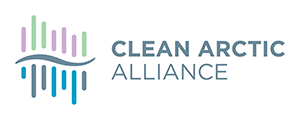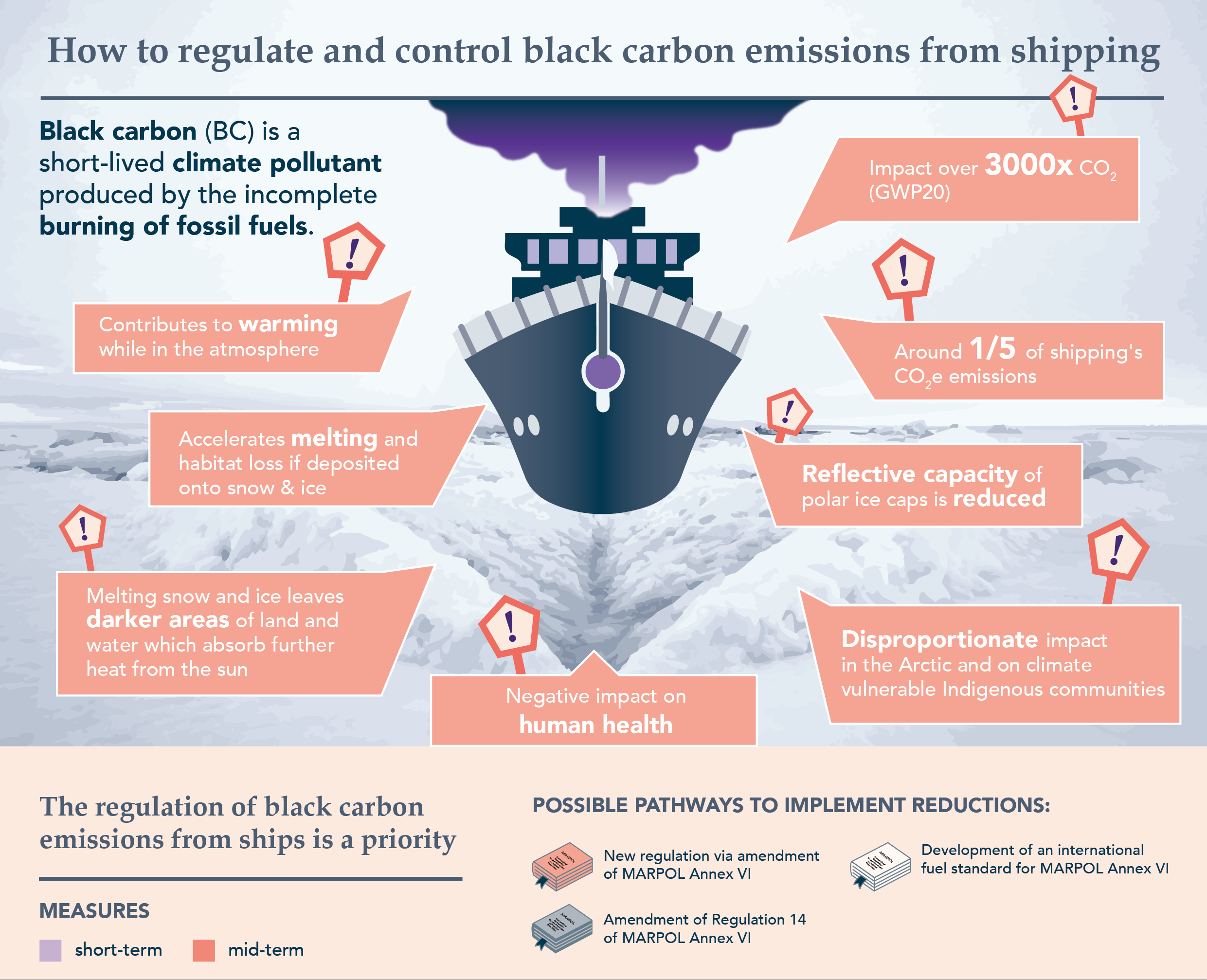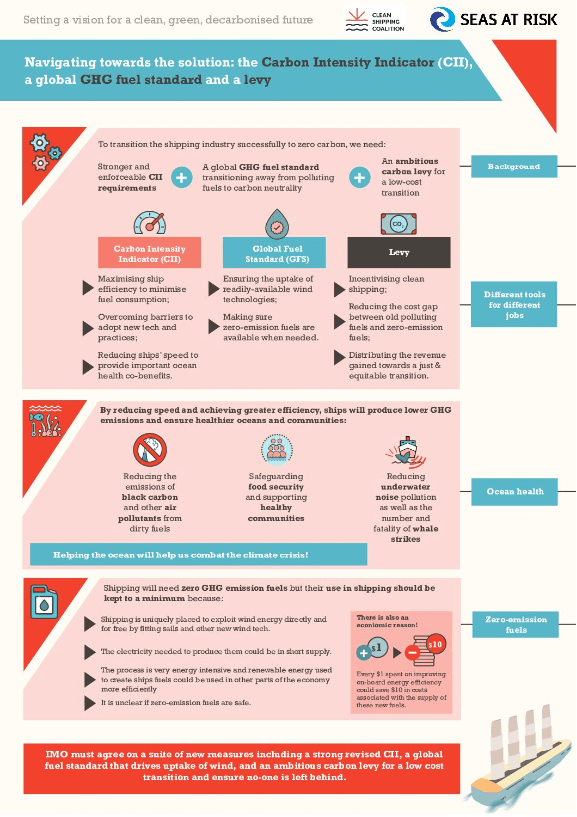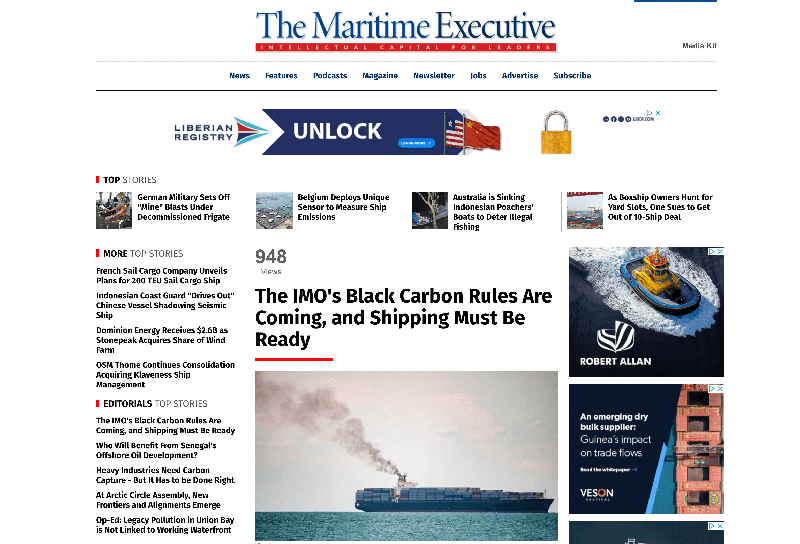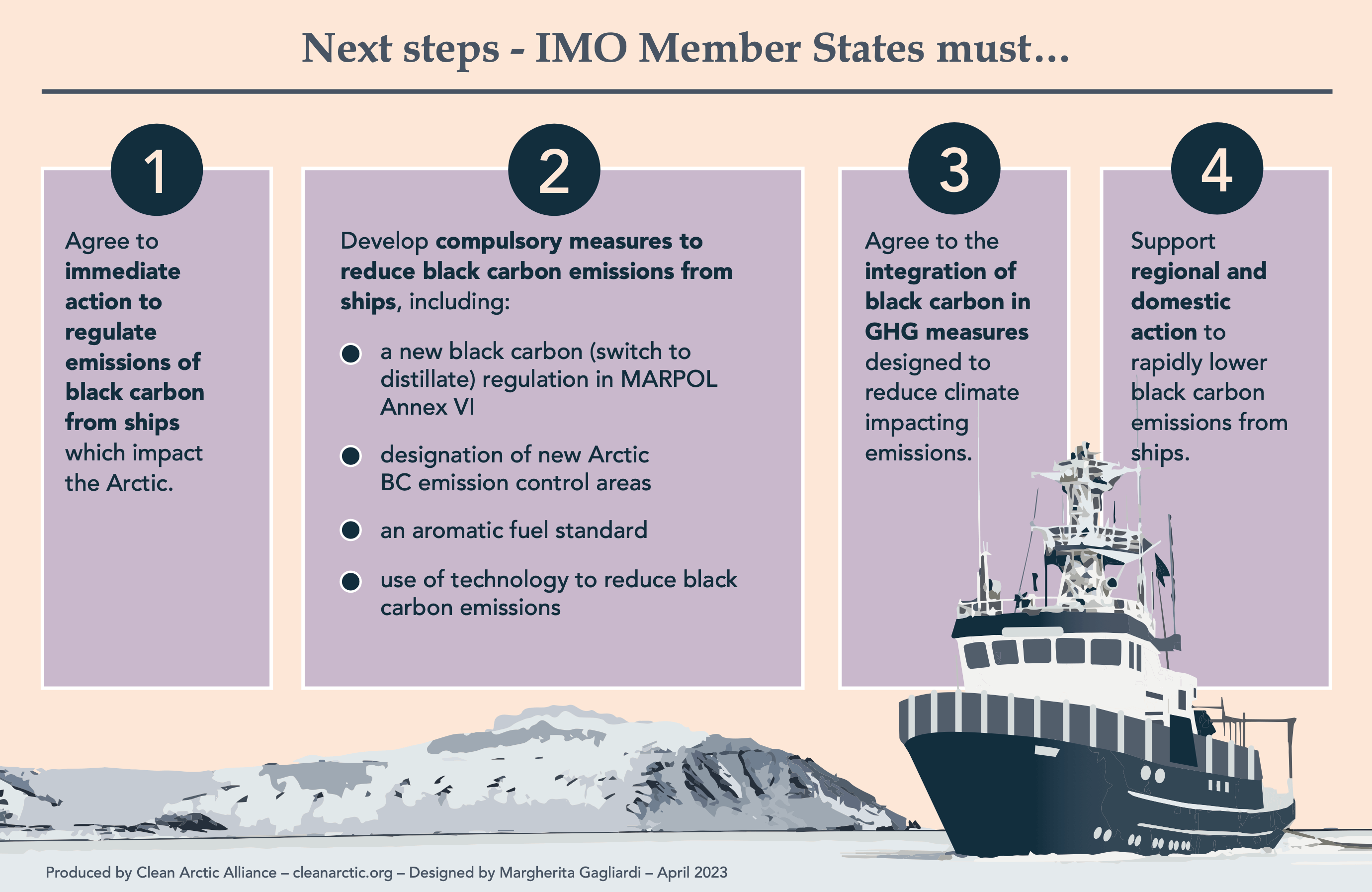London, 30 September, 2024: – As a meeting of the International Maritime Organization’s Marine Environment Protection Committee (IMO, MEPC 82) opens today, the Clean Arctic Alliance urges IMO member states to regulate emissions of black carbon from shipping in and near the Arctic, and to ban the use of scrubbers in the region.
Context: 2023 was the fourth warmest Arctic year on record. Meanwhile a recent report shows that Earth may have breached seven of nine planetary boundaries – the latest being ocean acidification, which is having its largest impact in the Arctic and Southern Oceans, while the National Snow and Ice Data Center reports that on September 11, Arctic Sea ice reached the seventh lowest on the satellite record. NSIDC notes that the 18 lowest minimums have all occurred in the last 18 years. According to a paper in Geophysical Research Letters, there has been a significant 24% reduction in Arctic sea ice reflective capacity – due in part to black carbon from gas flaring and other sources – including shipping.
IMO Paper: MEPC 82/7/17: Global Tipping Points – Reduction of Greenhouse Gas Emissions from Ships
”During MEPC 82 the IMO must finally commit to developing new regulations which would identify fuels suitable for use by international shipping in the polar regions, which would deliver an immediate fuel-based reduction in black carbon emissions which impact the Arctic”, said Dr Sian Prior, Lead Advisor to the Clean Arctic Alliance. “With a changing Arctic having detrimental impacts on weather systems around the world, and after more than a decade of deliberation, it is time governments finally started to regulate emissions of short-lived climate forcers such as black carbon from international shipping.”
“Even though this committee has met 21 times in the last decade and a half since agreeing to address emissions of black carbon, the shipping sector continues to emit climate forcing pollutants, without any regulation”, added Prior. “Even worse, emissions of black carbon from ships sailing in and near to the Arctic, which have a disproportionate impact when the particles settle onto snow and ice, have increased by 37% in 10 years. The downward trend in Arctic sea ice since the early 1980s shows that we have lost nearly 10% of the sea extent every decade, which during the month of August, equates to an area roughly six times the size of France.”
“Frustratingly, we have also known for a long time how to start reducing emissions of black carbon – we don’t need new fuels or new technology to kick-start black carbon emissions reductions – we simply need ships to all move to cleaner distillate fuels while operating in and near to the Arctic (north of 60oN latitude) and diesel particulate filters to be installed. This would see reductions of over 90% in black carbon emissions”, said Prior.
Infographic: How to regulate and control black carbon emissions from shipping
The Clean Arctic Alliance is also calling on MEPC 82 to agree to ban the use of exhaust gas cleaning systems (or scrubbers) as an alternative to moving to cleaner fuels when operating in the Arctic. Using a scrubber results in the production of large volumes of wastewater – over 10 gigatons are discharged by ships globally every year. The wastewater is acidic and can be contaminated with heavy metals, nitrates and nitrites and polyaromatic hydrocarbons (PAHs) and toxic to marine life at very low concentrations. The Clean Arctic Alliance believes that allowing scrubbers to be used by ships to circumvent moving to cleaner fuels is contrary to both the intent of the IMO’s own regulation which says that alternative compliance mechanisms should not impair or damage the environment, human health, property or resources and to the obligations of IMO Member States under the UN Convention on the Law of the Sea.
“In addition to an Arctic ban, at MEPC 82, IMO Member States must also agree to develop and adopt a resolution calling on shipping operators to immediately stop the release of scrubber discharge wastes in coastal and marine protected areas, critical habitat for endangered species, IMO designated Special Areas and PSSAs and other ecologically sensitive areas”, said Eelco Leemans, Clean Arctic Alliance Technical Advisor. “Scrubbers are the shipping industry’s attempt to continue using Heavy Fuel Oil (HFO), the dirtiest of all fuels, which should play no part in the future of shipping. In fact scrubbers are an obstacle in IMO’s climate ambitions. The short term solution is that ships switch to distillate fuel, whereby scrubbers are not needed..
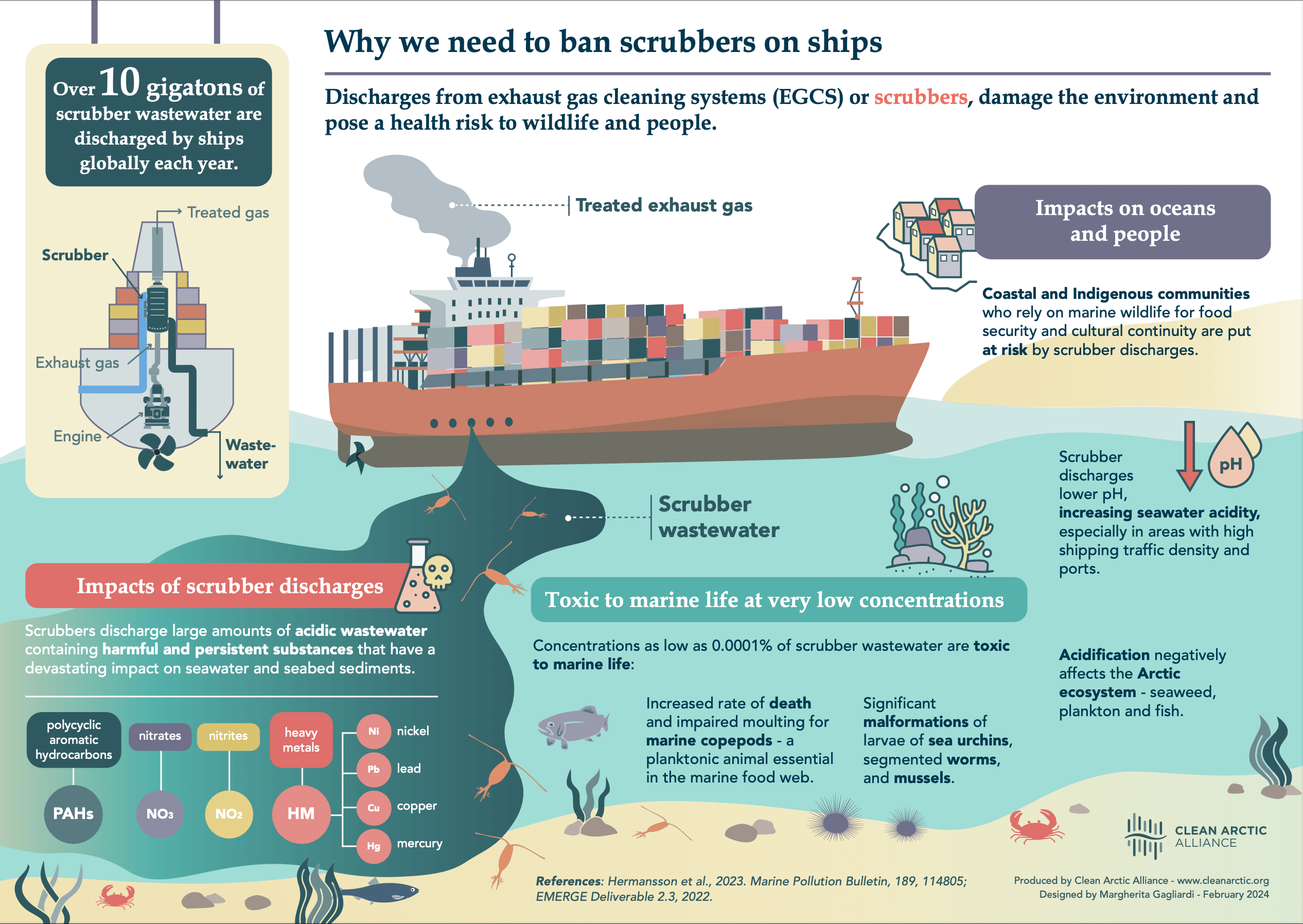
- Op-ed on Scrubbers: The shipping industry’s greenwashing deception
- IMO Paper: MEPC 82/5: Legal analysis on exhaust gas cleaning systems as an alternative compliance mechanism under MARPOL Annex VI from an air quality impact perspective
- IMO Paper: MEPC 82/5/4: Air Pollution Prevention: EGCS pollution in Pacific Canada: investigation of Canada
Other matters to be discussed and agreed at MEPC 82 include the designation of two new Emission Control Areas (ECAs) – in Canadian Arctic waters and in the Norwegian Sea. These were given preliminary approval at the last meeting and should be adopted this week.
“The Clean Arctic Alliance strongly encourages the IMO to designate these two new emissions control areas”, said Carolina Silva, Shipping Policy Officer at ZERO. “If these ECAs are created in Canadian Arctic waters and in the Norwegian Sea, ships will be required to reduce their sulphur and nitrogen emissions (SOx and NOx) by using cleaner fuels with a co-benefit being a reduction in black carbon emissions. Although ECAs do not fully address the concern about black carbon emissions, their role in reducing SOx and NOx emissions is also important both for the Arctic and in terms of human health and can pave the way for further ECA proposals to come forward.”
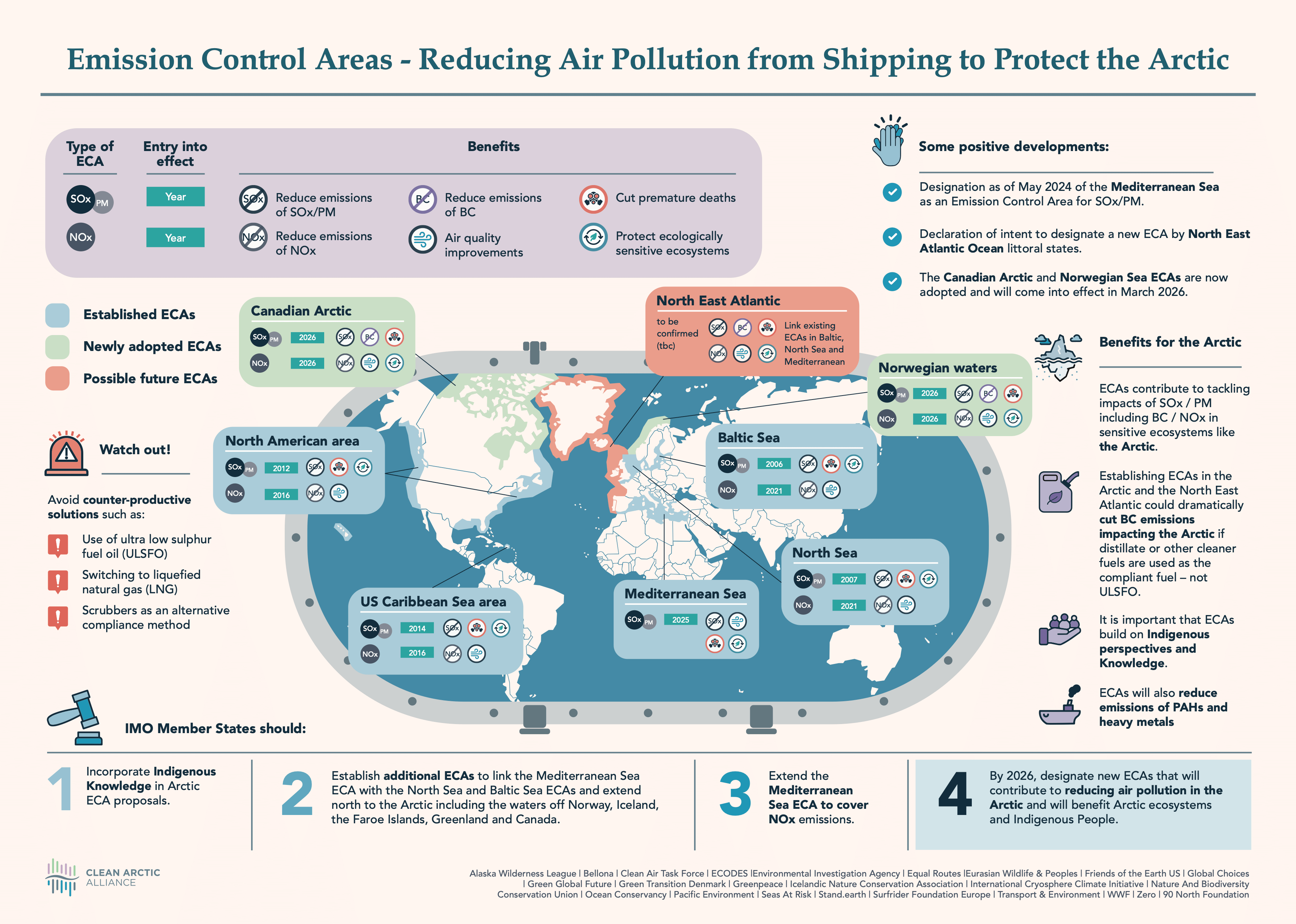
Infographic: Emission Control Areas – Reducing Air Pollution From Shipping
Other work just commencing at MEPC 82 will be the revision of the IMO’s carbon intensity indicator (CII). The CII is one component of a suite of measures that are being – revised in the case of the CII – and negotiated in the case of a global fuel standard and a carbon levy, which together will achieve the goals of the IMO’s greenhouse gas strategy and put shipping on an unambiguously 1.5oC compliant pathway – provided that the measures are sufficiently ambitious. Work to revise the CII will commence at MEPC 82, and must incorporate energy efficiency measures such as improving the operational efficiency of ships and reducing the amount of fuel used that deliver significant benefits for the prevention and reduction of underwater noise and ocean health more broadly, along with an effective enforcement mechanism to sure that emission reductions are reliable and real. The work needs to be concluded in 2025.
“It’s urgent to prioritise solutions for the shipping sector which are at the intersection of climate, biodiversity and pollution. Working to eliminate black carbon emissions and scrubber wastewater, and reducing underwater radiated noise in the Arctic all contribute to addressing shipping at this nexus and responding to the triple planetary crisis”, said Andrew Dumbrille, North American Advisor to the Clean Arctic Alliance. “We’re calling for a new task force to be initiated at MEPC 82 which would design a co-benefits solutions space at the IMO, creating a tide to raise all ships and accelerate the sustainability of the marine sector.”
About Black Carbon and the Arctic
In a paper submitted to the meeting (MEPC 82/5/2*: Regulating Black Carbon emissions from international shipping impacting the Arctic) NGOs called on IMO Member States to consider the development of a new regulation for inclusion in MARPOL Annex VI (the main international treaty addressing air pollution prevention requirements from ships) which would identify suitable polar fuels, for example distillate fuels, such DMA or DMZ, to deliver an immediate fuel-based reduction in black carbon emissions from international shipping impacting the Arctic. The paper develops the concept of “polar fuels” discussed at PPR 11 and sets out the fuel characteristics that would distinguish polar fuels from residual fuels and thus lead to fuel-based reductions in ship Black Carbon emissions if mandated for use in and near the Arctic.
Black carbon is a short-lived climate pollutant, produced by the incomplete burning of fossil fuels, with an impact more than three thousand times that of CO2 over a 20 year period. It makes up around one-fifth of international shipping’s climate impact. Not only does it contribute to warming while in the atmosphere, black carbon accelerates melting if deposited onto snow and ice – hence it has a disproportionate impact when released in and near to the Arctic. The melting snow and ice exposes darker areas of land and water and these dark patches then absorb further heat from the sun and the reflective capacity of the planet’s polar ice caps is severely reduced. More heat in the polar systems – results in increased melting. This is the loss of the albedo effect.
Declines in sea ice extent and volume are leading to a burgeoning social and environmental crisis in the Arctic, while cascading changes are impacting global climate and ocean circulation. Scientists have high confidence that processes are nearing points beyond which rapid and irreversible changes on the scale of multiple human generations are possible. Scientists say it is now too late to save summer Arctic sea ice, and research has shown that “preparations need to be made for the increased extreme weather across the northern hemisphere that is likely to occur as a result.”
Black carbon also has a negative impact on human health, and recent research has found black carbon particles in the body tissues of foetuses, following inhalation by pregnant mothers.
The need to reduce emissions of black carbon because of both the climate and health impacts has been long recognised. On land, considerable effort has been made to ban dirtier fuels in power stations, to install diesel particulate filters on land-based transport, and to improve the burning of dry wood – all to reduce emissions of black carbon and improve air quality. However, at sea the same efforts have not yet been made.
Find out more about black carbon
Infographic: Liquefied Natural Gas (LNG) is a threat to the Arctic
ENDS
Contact:
Dave Walsh, Communications Advisor, [email protected], +34 691 826 764
About the Clean Arctic Alliance
Made up of 23 not-for-profit organisations, the Clean Arctic Alliance campaigns to persuade governments to take action to protect the Arctic, its wildlife and its people.
Members include: Alaska Wilderness League, Bellona, Clean Air Task Force, Ecology and Development Foundation ECODES, Environmental Investigation Agency, Equal Routes, Eurasian Wildlife and Peoples, Friends of the Earth US, Global Choices, Green Global Future, Green Transition Denmark, Greenpeace, Iceland Nature Conservation Association, International Cryosphere Climate Initiative, Nature And Biodiversity Conservation Union, Ocean Conservancy, Pacific Environment, Seas At Risk, Surfrider Foundation Europe, Stand.Earth, Transport & Environment, WWF and Zero.
More more information visit https://www.cleanarctic.org/
